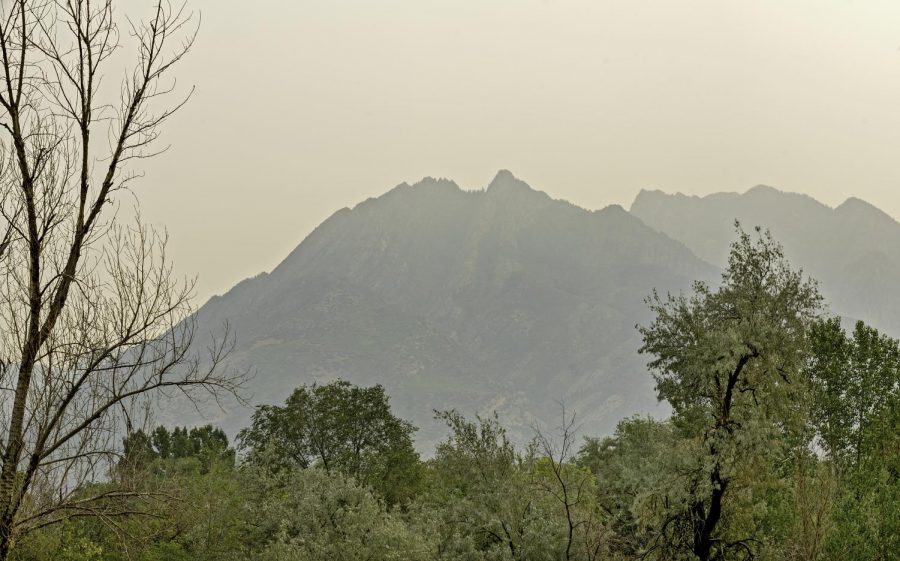Brown: Wildfires Aren’t Just a Climate Change Issue
A view of the smoke covered peak of Mt. Olympus. Image was taken on Monday, Aug. 9, 2021. (Photo by Kevin Cody | The Daily Utah Chronicle)
August 13, 2021
One of my earliest memories is driving home from a family reunion in southern Utah during a raging wildfire. The stinging smell of smoke and the heat radiating throughout the car is imprinted in my mind. Every year, when I go down south, I see the effects of this wildfire and others.
Since 1983, there have been three years where 10 million acres were burned from wildfires; all of these happened in just the last seven years. By all available metrics, wildfires in the United States are getting worse. But how do we stop them? While climate change is certainly to blame for a portion of worsening wildfires, it’s important to look at short-term fixes that could significantly reduce the environmental impact we’re seeing yearly.
The simplest way to look at the increasing damage caused by wildfires each year is through the lens of climate change. As the Earth gets warmer and drier, studies show increased droughts and longer wildfire seasons. These conditions allow certain insects that feast on trees, thus weakening their fire defense, to thrive. For example, the mountain pine beetle has caused significant forest damage in Idaho.
While the effects of climate change haven’t seemed to change the number of wildfires each year (the total number of wildfires is actually down from the late 1980s), their intensity has grown. Warmer temperatures have increased droughts, making trees and brush drier and more flammable.
With widening the range of wildfire season, blackened, dead trees have become a much more common sight. Many people in the Western United States live with the fear that a wildfire will come too close. In some cases, they already have. This June, the Knolls Fire of Saratoga Springs, Utah damaged and destroyed homes. Each year, these reports become more common.
Obviously, the holistic fix is to slow and adapt to the effects of climate change, but with scientists saying that it could take several decades, it’s not an immediate solution. Climate change undoubtedly worsens the effect of wildfire season each year, but with a long-term solution so far out, it’s important to do what we can right now.
In the September 2020 Presidential Debate, former President Donald Trump took aim at California Governor Gavin Newsom, claiming California’s neglectful forest management led to a great increase in the severity of wildfires in his state.
While that debate was something that most people would like to forget, Trump made a good point. A common strategy to reduce the impact of wildfires is to control how dense forests can get. Often done through controlled burns, these strategies seek to reduce the flammability of forest floors, making wildfires easier to control. Fire experts say that California forests have been mismanaged, and much greater efforts are needed to slow intense fire damage.
But Trump did make an important oversight in his argument. In California, 57% of forests are federal land, meaning from 2016-2020, it was partially his job to fund forest management in California. Unfortunately, that funding was hard to come by.
The budget for the National Forest Service, responsible for wildfire management on federal lands, decreased every year of Trump’s presidency. So, while he was correct in pointing out Governor Newsom’s missteps, his own actions made it difficult to mitigate the effects of wildfires. Forest management is vital to keeping wildfire damage low, and without funding on the state or federal level, the job will never get done.
Most of the fixes for the growing wildfire threat come at a political level, but individuals can be a part of the solution. There are plenty of ways you can contribute to mitigating wildfire damage. The simplest action is to not start fires you can’t control. More than 80% of wildfires each year are human-caused and are almost always preventable. By following basic fire safety guidelines, thousands of acres can be saved.
Next, don’t stop fighting to slow the effects of climate change. Just because it would take a long time to reverse doesn’t mean the effort isn’t necessary. Get out and protest. Call your legislators. Continue being the generation that fights climate change.
Finally, don’t fall into the trap of believing that forest management harms the environment. While there are examples of controlled burns gone awry, the benefits cannot be overstated. Of course, we should demand controlled burns in a smart and safe way, but without them, we’d be toast. If you live in the Western U.S., you’ve likely been affected — or know someone who has been affected — by a wildfire. While it may seem like just a political issue, it’s also up to each of us to slow them down.
At the end of every wildfire season comes more concern about just how bad these fires can get. More homes will be affected, and fires will get harder to control. Wildfires are getting worse and there’s no way around it. But we can mitigate them. By continuing the fight against climate change, wildfires will reduce in severity, but that will take time. For now, the focus must be slightly shifted towards forest management funding and personal responsibility. Believe and push for the benefits of forest management. Most of all, be safe when handling fire because, as some bear once told me, “only you can prevent forest fires.”









